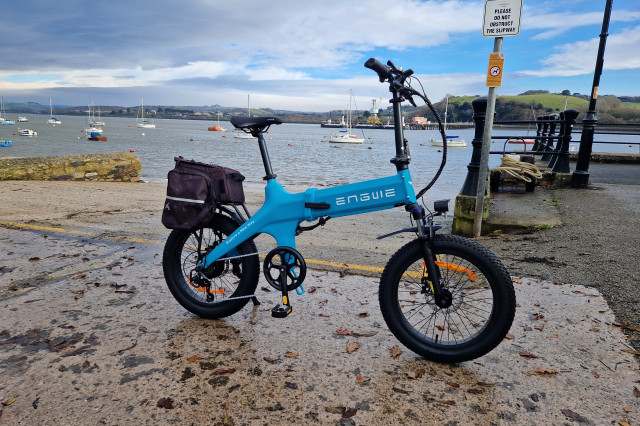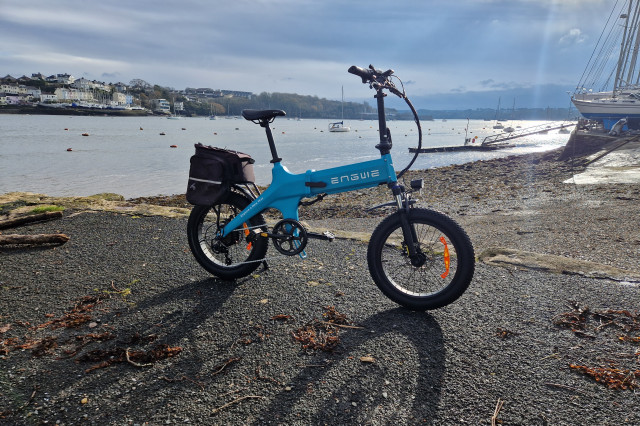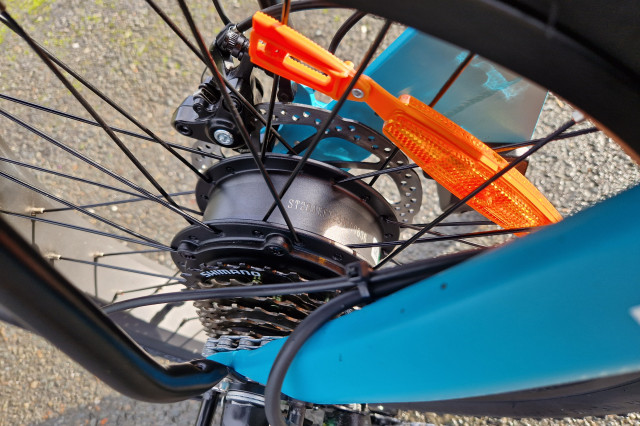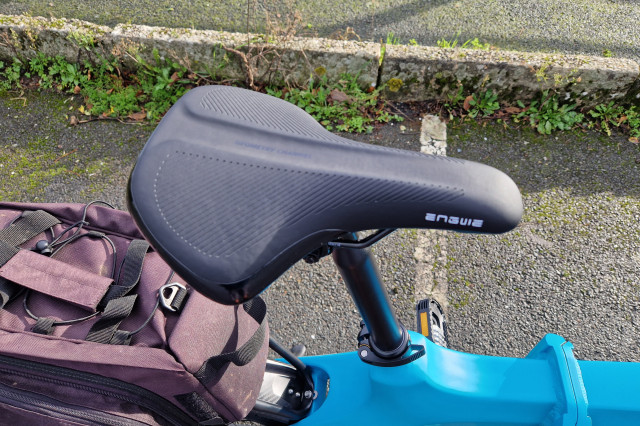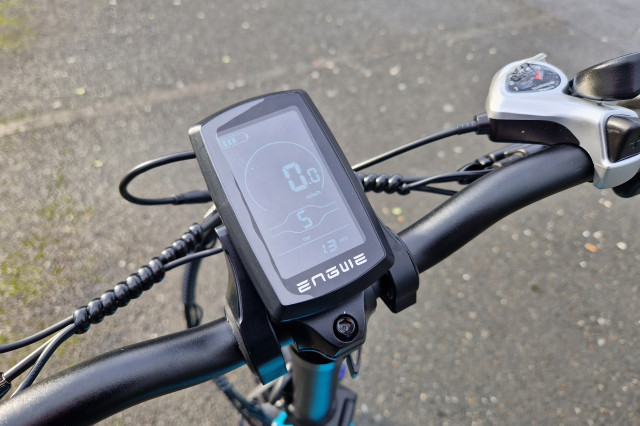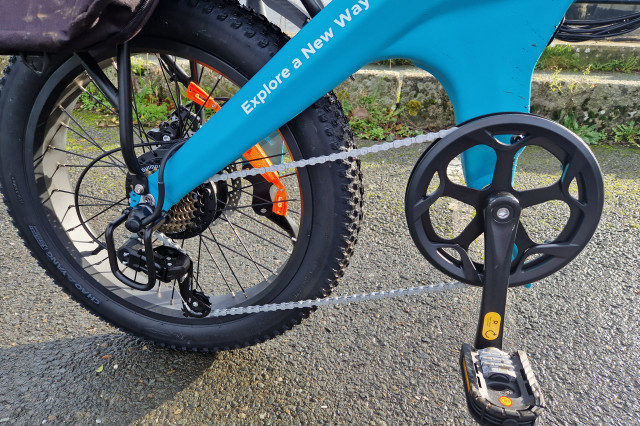Engwe C20 Pro
Overview
- Comfortable
- Plenty of power
- Battery range
- Delay in pedal assist
- Too heavy for a folding e-bike
- Rusting bolts after only a few weeks
The Engwe C20 Pro is a folding e-bike that bridges the gap between its full-fat siblings and more traditional folders (think of it as semi-skimmed). Instead of bulbous 4” tyres, the C20 has more road-friendly 3” tyres, which offer welcome relief from poor road surfaces. Although it’s still a handful to cart around, it’s much more manageable than the heavier Engwe Engine X.
Finding a good, solid folding e-bike with a decent battery range and a good comfort level isn’t easy in the sub-£1,000 price bracket. The C20 Pro has a class-leading 562Wh battery and a very smooth 250W rear hub motor. That does come at the expense of a significant weight penalty, tipping the scales at 25kg, but it’s a lot lighter than its big brother (which weighs 32kg).
The Enwge C20 Pro has an RRP of £949, making it a very tempting proposition. It certainly cuts an imposing figure with its big tyres, chunky frame and front suspension fork. But is it all show and no go? I’ve been riding it regularly for the last couple of months to find out.
The ride
The first thing that struck me about the Engwe is the size. It’s big for a folding e-bike, and I had no trouble adjusting it to accommodate my 6ft frame. For my first ride, I decided to brave the elements and take it on my usual test route up to the edge of Dartmoor.
Having ridden all three of Engwe’s fat tyre folding e-bikes, I was curious to see how this lighter model would perform, and I was pleasantly surprised. The smaller tyres make it less cumbersome at lower speeds and it feels more like a regular folding bike. There’s still a little road noise from the semi-knobbly tyres, but it’s not Land Roveresqe like with other models.
The performance is what I expected from the 250W rear motor. Once underway, it’s smooth and builds speed nicely. The C20 Pro uses a cadence sensor, and there is a delay in the pedal assist, which can prove challenging for hill starts. A half-twist throttle is fitted, but it’s disabled - which is confusing as it could have been set to the UK limit of 6km/h. That way, you would have a little push to get going.
Where the Engwe excels is on gently rolling terrain. Here, the motor is in its element. Its limitations become apparent only when you reach steeper hills. Anything above a 10% gradient, and you’ll have to be prepared to help the little motor considerably. Another slightly annoying quirk is if you’re approaching a hill above the assistance limit, there's a lag before it kicks back in again. By the time the motor restarts, your speed will have slowed to single digits.
There are five levels of assist to choose from, but you only get the top assisted speed in level 5. I kept at the highest level for the duration of the ride, which was about 25 miles. The battery had two out of five bars remaining at the end, indicating a real-world range of 30-40 miles.
What’s it like to live with on a daily basis? Not bad, actually. In fact, I’ve become quite attached to it. It’s a laid-back, easy bike to ride and great for running errands. The Engwe has soldiered on despite constant rain and being left outside in the elements. Apart from a few rusting bolts, it hasn’t caused me any problems. More recently, it has carried on through the cold snap without issue.
Specification
The Engwe C20 Pro has a tough-looking aluminium frame. It has a somewhat utilitarian look with a big box section main beam that houses the battery. The paintwork and general finish of the bike are good, but as mentioned above, some of the bolts are starting to rust.
Power is provided courtesy of a 36V 250W rear hub motor. The motor is branded Sutto, a subsidiary of e-bike motor giant Bafang. After the initial delay on start-up, the power comes on smoothly and fades out just as smoothly once the 15.5mph assist limit is reached. Beyond the cut-off point, pedalling quickly becomes a chore unless the road is completely flat. There isn’t any noticeable resistance from the motor, but the heavy weight and big tyres will hamper unassisted progress.
The display is clear and easy to read, although glare on the screen will make it less so in the summer months. It has plenty of functionality and looks smart, too. The control pad is on the left, where you can incrementally adjust the assist level from 1 to 5, switch on the lights or change certain settings.
The battery is a generous 36v 15.6Ah (562Wh). Engwe claims a range of 37 miles, and based on my testing, I’d say this is not far off what can be achieved. If you leave it in the highest assist level, you can expect around 30 miles. It can be charged in situ or removed for charging indoors. There is a lock on the underside - once you lock the battery in place, the key cannot be removed. Removing the battery is a bit of a faff - you need to unlock it, then open the main folding mechanism and unfold the bike, which exposes the battery handle.
There are no surprises regarding the gearing - 7-speed Shimano Tourney with single front chainring and thumb shifter. The gear range is fine for bombing around town, but you’ll run out of gears above 18mph. At the other end of the scale, the gearing isn’t quite low enough for really steep hills.
The mechanical disc brakes with 160mm rotors are adequate, although I wouldn’t say they inspire confidence. They are set up to the European standard, so your front is on the left, and rear is on the right. They can get quite noisy when wet.
Up front, there is a basic suspension fork with preload adjustment and lock-out. It functions just fine for riding on the road and does its job on potholes and drains. If you’re feeling a bit more adventurous, I’d say it would cope well with unsurfaced cycle paths and maybe forest trails, but I wouldn’t advise tackling anything too challenging.
The 20” x 3” tyres have remained resistant to punctures through the two-month testing period, despite one of my regular routes being routinely littered with broken bottles. The wheels seem sturdy, with no broken spokes to report.
The handlebars are a nice width for a folding bike, and the steering height can be adjusted to suit rider preferences. The seat post height can be adjusted via a quick-release clamp. Finally, the saddle is surprisingly comfortable. Usually, they fit soft and squishy saddles to these bikes, but the one fitted on the C20 is quite firm and has a nice shape.
Regarding accessories, there is everything a daily commuter would need. The lights are adequate, and the rear light has a built-in stop light, which is a nice touch. The rear pannier rack has a 25kg weight limit, and had no problems carrying groceries. The plastic mudguards are a bit of an afterthought, and although they stop some road spray, they are not as good as the full-length mudguards fitted to similar bikes.
If you need to fold it for transportation, the process is easy enough, but be warned, it’s heavy at 25kg. Trying to cart this around could give you a hernia - especially if you need to lift it into the back of a vehicle. As for taking it on and off public transport, I personally wouldn’t recommend it.
Sizing
The C20 Pro is a big bike. Their product page states it’s suitable for riders between 5ft and 6ft, but I would say it’s more like 5ft6in to 6ft4in.
The seat post will only go down so far, unless you shorten it. As I said above, I felt completely at home on it, and I’m 6ft.
Value and competition
There’s no disputing that the Engwe C20 Pro is good value for money, but how does it stand up to the competition?
The Mycle Charge comes in at £1,299 and has a lower battery capacity, but it does come from a UK-based brand with good customer support. The Carrera Crosscity from Halfords is the same price and much easier to transport, but it has a much lower spec.
A little more expensive, but significantly lighter and nicer to ride is the Estarli e20.7, which is available for £1,480 with mudguards, rack and lights. Or if you're an around town e-bike that can be folded when not in use, the £1,299 Ado Air 20 is an easy-to-live-with single speed option with a belt drive.
Conclusion
At first, I wasn’t so sure about the Engwe E20 Pro - I’ve never been a fan of fat tyre e-bikes - but this one offers a good compromise. As a tool for getting you from A to B, it’s hard to fault. It gets you around without too much fuss, although it’s a pig to pedal without the motor helping you along.
Where it falls short is its size and weight. It’s not going to be practical to transport in the way something like a Brompton is - but then they of course cost three times as much. If you’re looking for a cheap, daily runabout with plenty of power and a decent battery range, it’s worth considering.
1 comments
This appears solely crafted to appeal to delivery riders.
The too big battery for the commuting an leisure market.
The obscene weight.
The pointless use of fat nobbly tyres combined with suspension forks.
This is mostly show over substance.
